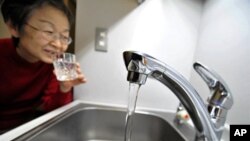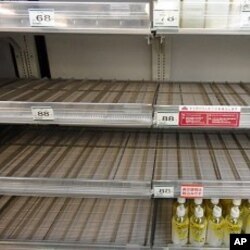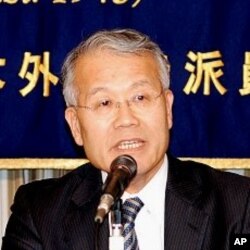Radiation spewing from a tsunami-battered nuclear power plant is causing wider concerns about Japan's food chain and water supply. Meanwhile, high radiation levels, smoke and other challenges at the facility in northeastern Japan are hampering efforts to quickly restore cooling systems to all six of its reactors.
Millions of people in Tokyo received a new, sobering alert on Wednesday. The metropolitan government announced radioactive iodine, exceeding the legal limit, has been detected at one of the city's primary water purification plants.
City officials say the affected downtown facility supplies much of the tap water for Japan's capital and five suburban districts. They say the level recorded in the water, drawn from local rivers, is nearly double that considered safe for infants to drink, but still within limits acceptable for adults to ingest.
Ei Yoshida, who heads the water purification division of the Tokyo Waterworks Bureau, says it can be assumed that the source of the contamination is the Fukushima-1 nuclear power plant, which was damaged by the March 11 magnitude 9.0 earthquake and resulting tsunami.
The announcement immediately prompted panic. Citizens began buying huge amounts of bottled water in Tokyo, with some purchasing it by the boxes.
Japan's government quickly asked the public to refrain from excessive purchases of water and said it is looking at ways to provide pure water to families with infants in the Tokyo Metropolitan area.
Earlier Wednesday, the Japanese government ordered shipments halted of additional varieties of vegetables from Fukushima prefecture. Spinach had initially tested for excessive levels of radioactive iodine and cesium. Among the contaminated vegetables added to the the list: broccoli, cabbage, cauliflower and parsley.
Those living in the prefecture, which has a population of two million people, have also been instructed to stop eating leaf vegetables harvested there.
Officials and scientists insist the levels of radioactive iodine and cesium detected in food, the air, soil and sea water, are not harmful to people.
The spreading radiation emanates from the crippled Fukushima-1 nuclear power plant. Its cooling system was knocked out by the tsunami. Efforts continue to restore the system and cool overheated reactors and fuel rods, which are emitting the higher than normal levels of radiation which are spreading over Japan.
Black smoke was seen rising late Wednesday afternoon from the damaged Number 3 reactor. The plant's operator, Tokyo Electric Power Company, released a photograph of the smoke, but says it does not know the cause. Utility spokesmen told reporters the latest sighting of smoke prompted the evacuation of the entire complex where workers have been desperately attempting to repair the cooling system and spray water on overheated fuel for nearly a week.
The company and the government nuclear safety agency say no rise in radiation levels was detected after the smoke rose.
The International Atomic Energy Agency says it suspects the Number 3 reactor’s fuel, a mix of plutonium and uranium, was damaged after the March 11 natural disaster and the condition of its spent fuel pool is uncertain.
Nagasaki University Professor Shunichi Yamashita, a specialist on radiation health risks, has been named an advisor to the Fukushima prefectural government. He says it is difficult to know the precise amount of radiation for every locality around the plant.
"The radiation cloud, the fallout, spreads not evenly over all areas. It's very heterogenous," he said. "It maybe depends on the wind, climate, temperatures, area and so on. Some areas it's surely high, spotty. Totally the other areas is a safe area. So I recommend to them, if possible, they should evacuate. Or should they stop eating the local products, even water."
With hundreds of thousands homeless or displaced people posing another major concern, the overwhelmed Japanese government is caring for survivors. Japanese media say some, especially the elderly, have begun to succumb in evacuation centers and hospitals because of cold weather or lack of adequate treatment.
The official death toll from the disasters is around 9,200 people. Nearly 14,000 people are listed as missing.
















